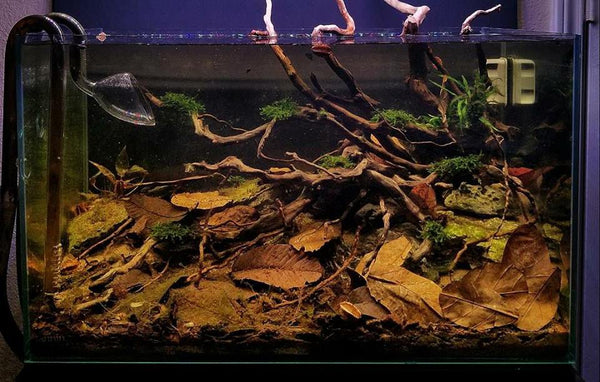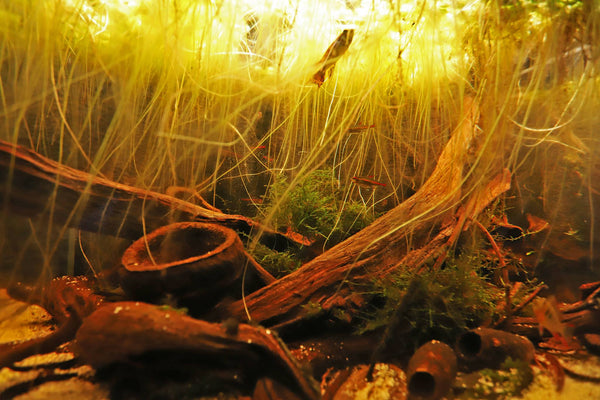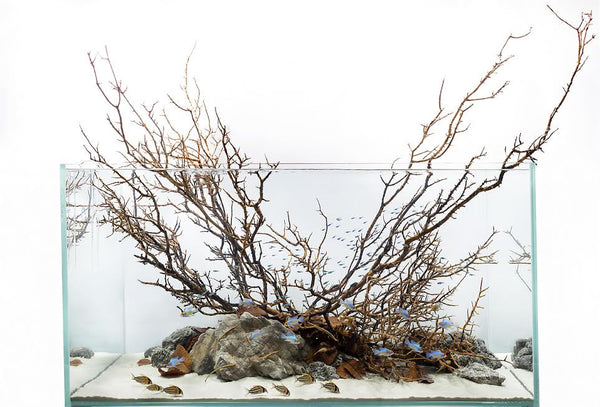- Continue Shopping
- Your Cart is Empty
Dreaming in water: The mindset behind the dream...
In our botanical-style, blackwater aquariums, we've discovered that there is so much more than just a different look, isn't there? There is an ability to utilize botanical materials in simple ways to create an amazing array of aesthetic vibes.

I learned this recently when I was collaborating with Johnny Ciotti on some of our "Studio Tannin" aquascapes.

This little adventure arose out of a request from our community. Many asked for "packages" of materials which would create a cohesive hardscape, which could either be set up as is, or used as the basis for a different sort of look.

And of course, when you have a friend who is one of the top aquascapers in the world, and has mad aesthetic skills, you're all too happy to work with him on the project!

I've worked with John on many projects before over the years (he's done our amazing You Tube videos), and I've seen him lay out a lot of 'scapes. His "resume" is truly diverse and amazing.

One of the things I am frequently surprised about is just how quickly some 'scapers can zero in on components that they feel will fit the look they have in mind. And interestingly, most of these guys and girls seem to do "more with less."
In other words, they tend to focus on using 4 or 5 elements really well, as opposed to the "kitchen sink" approach that I have used so often over the years- you know, tossing in a huge variety of materials to set the stage of the tank.
John has this mastered, and it's interesting to see him use just a few botanicals and wood elements to achieve a harmonious look. It's a balance of artistic eye, innate sense of what he's trying to achieve, and a real aesthetic discipline...

And his ability to interpret nature in a truly artistic way has always stunned me.

Watching 'scapers like Johnny in action always leaves me in awe. The discipline is perhaps the most impressive thing to see. The ability to say "Done."
Now sure, there ARE many scenarios where you'd want to use a larger variety of materials. For example, if you're attempting to replicate a habitat like an inundated forest floor, where lots of materials aggregate, this is spot on. Or, perhaps you're trying to replicate a section of a stream bed with a complex array of root tangles, or whatever.

There is a time and place for everything, right? Another important lesson.
The great aquascapers seem to use exactly what they need to express the vibe they want. Nothing more. Nothing less. That's a mad skill, IMHO. A skill that I am slowly learning after decades!
Cory Hopkins comes to mind when you look at someone who has created some truly complex aquaecapes using botanicals, yet ones which reflect beautifully the scene he is trying to replicate. His aquascapes reflect a deep understanding of the materials he's using.

And yes, Cory has a greed to do some "Tannin Studio" scapes, too, so it will be fun to see a variety of different looks from different 'scapers! Even with his love of intricate detail, Cory's tanks reflect a wonderful simplicity and "vibe" of natural processes in action.

And then there are guys like George Farmer, who have an uncanny sense of the whole scene; seeing how the tank will look weeks or months down the line. I don't know if it's the way he places materials, the orientations or layouts he chooses, or what, but it just seems that George's tanks become more and more "understandable" as they evolve, and he just knows this from the outset.

I think perhaps it's because he's a very plant-knowledgable 'scaper, and takes a sort of different view, knowing that plants will grow in. There is something about his work that everyone just loves!

Thee thing that always strikes me about studying the work of each of these guys is that they have distinct styles of their own, which I always thought was kind of cool.

Like, you could look at one of John's tanks and not be told it was him, but you'd just sort of know it.

Same with George or Cory, or our friend Jeff Senske of Aquarium Design Group.

ANd I think they'd be the first to argue that we ALL have style, talents, and vision. Beyond simple humility and the ability to do a classic "Iwagumi" style rock layout, each of them has a huge dose of appreciation for the work of others. They'll all tell you how cool that wood scape you just did was, perhaps offering a suggestion on a slight tweak, but that's it. They appreciate the raw ability and talent that we all have inside ourselves.
And we all do.

When you share pics of your aquariums with us, we are blown away by the unlimited number of interpretations of the botanical-style aquarium that there are. Some of you want hyper-realistic biotope style aquariums, and your work reflects that. Others simply want to add botanicals to existing "conventional" tanks, and that's fun to see, too. Some of you are very experimental, trying things like all-botanical substrates, where, despite their attractiveness, it's more about the function. Amazing.

We'll keep nuancing the "Studio" line to reflect different styles, tank sizes, "vibes", budgets, and interests. We hope for them to not only provide you with the basis for creating an amazing aquarium, but as a way to inspire you to blaze your own way, utilizing our botanicals and other natural materials to create beautiful displays which bring you pleasure and enjoyment for years to come.
We all have skills. We all have style. We all have taste.
We dream in water.
Stay creative. Stay original. Stay engaged. Stay excited.
And Stay Wet.
Scott Fellman
Tannin Aquatics











Scott Fellman
Author